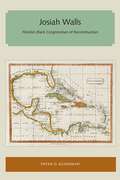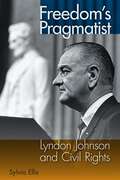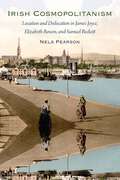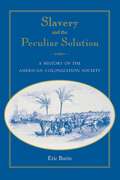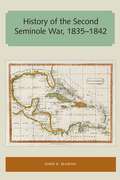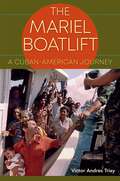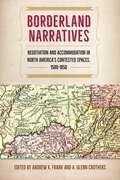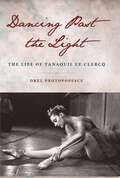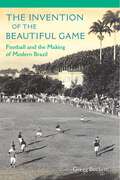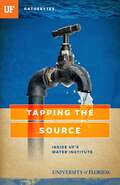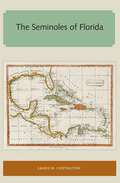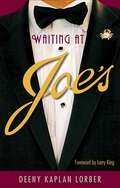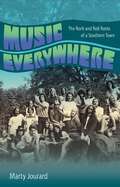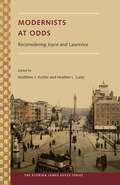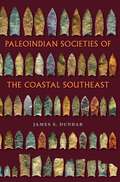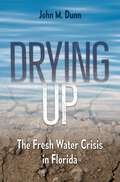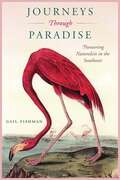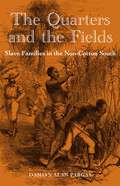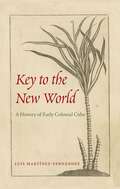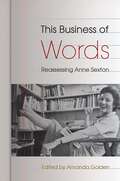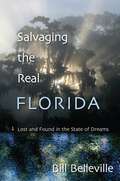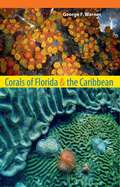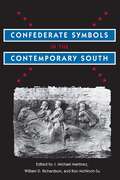- Table View
- List View
Josiah Walls: Florida's Black Congressman of Reconstruction (Florida and the Caribbean Open Books Series)
by Peter D. KlingmanThe books in the Florida and the Caribbean Open Books Series demonstrate the University Press of Florida’s long history of publishing Latin American and Caribbean studies titles that connect in and through Florida, highlighting the connections between the Sunshine State and its neighboring islands. Books in this series show how early explorers found and settled Florida and the Caribbean. They tell the tales of early pioneers, both foreign and domestic. They examine topics critical to the area such as travel, migration, economic opportunity, and tourism. They look at the growth of Florida and the Caribbean and the attendant pressures on the environment, culture, urban development, and the movement of peoples, both forced and voluntary.The Florida and the Caribbean Open Books Series gathers the rich data available in these architectural, archaeological, cultural, and historical works, as well as the travelogues and naturalists’ sketches of the area prior to the twentieth century, making it accessible for scholars and the general public alike.The Florida and the Caribbean Open Books Series is made possible through a grant from the National Endowment for the Humanities and the Andrew W. Mellon Foundation, under the Humanities Open Books program.
Freedom's Pragmatist: Lyndon Johnson and Civil Rights
by Sylvia EllisHistory has labeled Lyndon B. Johnson "Lincoln's successor." But how did a southern president representing a predominately conservative state, with connections to some of the nation's leading segregationists, come to play such an influential role in civil rights history? In Freedom's Pragmatist, Sylvia Ellis tracks Johnson's personal and political civil rights journey, from his childhood and early adulthood in Texas to his lengthy career in Congress and the Senate to his time as vice president and president.Once in the White House, and pressured constantly by grassroots civil rights protests, Johnson made a major contribution to the black freedom struggle through his effective use of executive power. He provided much-needed moral leadership on racial equality; secured the passage of landmark civil rights acts that ended legal segregation and ensured voting rights for blacks; pushed for affirmative action; introduced antipoverty, education, and health programs that benefited all; and made important and symbolic appointments of African Americans to key political positions.Freedom's Pragmatist argues that place, historical context, and personal ambition are the keys to understanding Johnson on civil rights. And Johnson is key to understanding the history of civil rights in the United States. Ellis emphasizes Johnson's complex love-hate relationship with the South, his innate compassion for the disadvantaged and dispossessed, and his political instincts and skills that allowed him to know when and how to implement racial change in a divided nation.
Irish Cosmopolitanism: Location and Dislocation in James Joyce, Elizabeth Bowen, and Samuel Beckett
by Nels PearsonDonald J. Murphy Prize for a Distinguished First Book "Pearson is convincing in arguing that Irish writers often straddle the space between national identity and a sense of belonging to a larger, more cosmopolitan environment."--Choice "Demonstrat[es]. . .just what it is that makes comparative readings of history, politics, literature, theory, and culture indispensable to the work that defines what is best and most relevant about scholarship in the humanities today."--Modern Fiction Studies "[An] admirable book . . . Repositions the artistic subject as something different from the biographical Joyce, Bowen, or Beckett, cohering as a series of particular aesthetic responses to the dilemma of belonging in an Irish context."--James Joyce Broadsheet "A smart and compelling approach to Irish expatriate modernism. . . . An important new book that will have a lasting impact on postcolonial Irish studies."--Breac "Clearly written, convincingly argued, and transformative."--Nicholas Allen, author of Modernism, Ireland and Civil War "Goes beyond 'statism' and postnationalism toward a cosmopolitics of Irish transnationalism in which national belonging and national identity are permanently in transition."--Gregory Castle, author of The Literary Theory Handbook "Shows how three important Irish writers crafted forms of cosmopolitan thinking that spring from, and illuminate, the painful realities of colonialism and anti-colonial struggle."--Marjorie Howes, author of Colonial Crossings: Figures in Irish Literary History "Asserting the simultaneity of national and global frames of reference, this illuminating book is a fascinating and timely contribution to Irish Modernist Studies."--Geraldine Higgins, author of Heroic Revivals from Carlyle to Yeats Looking at the writing of three significant Irish expatriates, Nels Pearson challenges conventional critical trends that view their work as either affirming Irish anti-colonial sentiment or embracing international identity. In reality, he argues, these writers constantly work back and forth between a sense of national belonging that remains incomplete and ideas of human universality tied to their new global environments. For these and many other Irish writers, national and international concerns do not conflict, but overlap--and the interplay between them motivates Irish modernism. According to Pearson, Joyce 's Ulysses strives to articulate the interdependence of an Irish identity and a universal perspective; Bowen's exiled, unrooted characters are never firmly rooted in the first place; and in Beckett, the unsettled origin is felt most keenly when it is abandoned for exile. These writers demonstrate the displacement felt by many Irish citizens in an ever-changing homeland unsteadied by long and turbulent decolonization. Searching for a sense of place between national and global abstractions, their work displays a twofold struggle to pinpoint national identity while adapting to a fluid cosmopolitan world.
Slavery and the Peculiar Solution: A History of the American Colonization Society (Southern Dissent)
by Eric Burin"An exceptional work that will stand for years as the best study of the African colonization movement. Burin's insights into this often misunderstood idea will be appreciated by all historians of the early national era. The research, both archival and secondary, is excellent."--Douglas Egerton, Le Moyne College "Burin adds significantly to our understanding of the world view of slaveholding colonizationists, of their negotiations with prospectively freed people, and of their struggle with proslavery critics of colonization. . . . Historians of proslavery thought will find new ideas and information here."--Torrey Stephen Whitman, Mount St. Mary’s College From the early 1700s through the late 1800s, many whites advocated removing blacks from America. The American Colonization Society (ACS) epitomized this desire to deport black people. Founded in 1816, the ACS championed the repatriation of black Americans to Liberia in West Africa. Supported by James Madison, James Monroe, Henry Clay, and other notables, the ACS sent thousands of black emigrants to Liberia. In examining the ACS’s activities in America and Africa, Eric Burin assesses the organization’s impact on slavery and race relations. Burin focuses on ACS manumissions—that is, instances wherein slaves were freed on the condition that they go to Liberia. In doing so, he provides the first account of the ACS that covers the entire South throughout the antebellum era. He investigates everyone involved in the society’s affairs, from the emancipators and freedpersons at the center to the colonization agents, free blacks, southern jurists, newspaper editors, neighboring whites, proslavery ideologues, northern colonizationists, and abolitionists on the periphery. In mixing a panoramic view of ACS operations with close-ups on individual participants, Burin presents a unique, bifocal perspective on the ACS. Although colonization leaders initially envisioned their program as a pacific enterprise, in reality the push-and-pull among emancipators, freedpersons, and others rendered ACS manumissions logistically complex, financially troublesome, legally complicated, and at times socially disruptive enterprises. Like pebbles dropped in water, ACS manumissions rippled outward, destabilizing slavery in their wake. Based on extensive archival research and a database of 11,000 ACS emigrants, Burin’s study offers new insights concerning the origins, intentions, activities, and fate of the colonization movement.
History of the Second Seminole War, 1835–1842 (Florida and the Caribbean Open Books Series)
by John K. MahonThe books in the Florida and the Caribbean Open Books Series demonstrate the University Press of Florida’s long history of publishing Latin American and Caribbean studies titles that connect in and through Florida, highlighting the connections between the Sunshine State and its neighboring islands. Books in this series show how early explorers found and settled Florida and the Caribbean. They tell the tales of early pioneers, both foreign and domestic. They examine topics critical to the area such as travel, migration, economic opportunity, and tourism. They look at the growth of Florida and the Caribbean and the attendant pressures on the environment, culture, urban development, and the movement of peoples, both forced and voluntary.The Florida and the Caribbean Open Books Series gathers the rich data available in these architectural, archaeological, cultural, and historical works, as well as the travelogues and naturalists’ sketches of the area prior to the twentieth century, making it accessible for scholars and the general public alike.The Florida and the Caribbean Open Books Series is made possible through a grant from the National Endowment for the Humanities and the Andrew W. Mellon Foundation, under the Humanities Open Books program.
The Mariel Boatlift: A Cuban-American Journey
by Victor Andres TriayAmerican Association for State and Local History Leadership in History Award in Local History - Honorable Mention Florida Book Awards, Gold Medal for Florida Nonfiction Set against the sweeping backdrop of one of the most dramatic refugee crises of the twentieth century, The Mariel Boatlift presents the stories of Cuban immigrants to the United States who overcame frightening circumstances to build new lives for themselves and flourish in their adopted country. Award-winning historian Victor Triay portrays the repressive climate in Cuba as the democratic promises of Fidel Castro’s 1959 revolution gave way to a communist dictatorship under which the people of the island became virtually cut off from the outside world. He illustrates how escalating internal tensions during the regime’s second decade in power culminated in an exodus of over 125,000 Cuban refugees across the Straits of Florida during the spring and summer of 1980. Alongside a fast-paced narrative offering a brief history of the Mariel Boatlift, Triay presents testimonies from former Mariel refugees who recall their lives in Cuba before the boatlift and how they longed to reunite with family members who lived in exile in the United States. Their captivating stories detail the physical and psychological abuse they endured in Cuba at the hands of pro-government mobs and the mistreatment many experienced at processing centers there before reaching the port of Mariel. They recall treacherous journeys to Key West aboard vessels that were deliberately overcrowded to life-threatening levels by Cuban authorities, as well as their experiences settling in Miami and beyond. Called the scum—escoria—of society by the Cuban government, a false portrayal accepted and spread by some in the American media, Mariel refugees faced extraordinary challenges upon entering U.S. society. Yet, despite the obstacles placed before them, the overwhelming majority of these immigrants successfully transitioned to their new lives as Americans and many have emerged as leading professionals, scholars, writers, artists, and businesspeople. This book shares their hardships and successes while profoundly illustrating the human impact of international power struggles.
Borderland Narratives: Negotiation and Accommodation in North America’s Contested Spaces, 1500-1850 (Contested Boundaries)
by Andrew K. Frank and A. Glenn CrothersBroadening the idea of "borderlands" beyond its traditional geographic meaning, this volume features new ways of characterizing the political, cultural, religious, and racial fluidity of early America. It extends the concept to regions not typically seen as borderlands and demonstrates how the term has been used in recent years to describe unstable spaces where people, cultures, and viewpoints collide.The essays include an exploration of the diplomacy and motives that led colonial and Native leaders in the Ohio Valley—including those from the Shawnee and Cherokee—to cooperate and form coalitions; a contextualized look at the relationship between African Americans and Seminole Indians on the Florida borderlands; and an assessment of the role that animal husbandry played in the economies of southeastern Indians. An essay on the experiences of those who disappeared in the early colonial southwest highlights the magnitude of destruction on these emergent borderlands and features a fresh perspective on Cabeza de Vaca. Yet another essay examines the experiences of French missionary priests in the trans-Appalachian West, adding a new layer of understanding to places ordinarily associated with the evangelical Protestant revivals of the Second Great Awakening.Collectively these essays focus on marginalized peoples and reveal how their experiences and decisions lie at the center of the history of borderlands. They also look at the process of cultural mixing and the crossing of religious and racial boundaries. A timely assessment of the dynamic field of borderland studies, Borderland Narratives argues that the interpretive model of borders is essential to understanding the history of colonial North America. A volume in the series Contested Boundaries, edited by Gene Allen Smith Contributors: Andrew Frank | A. Glenn Crothers | Rob Harper | Tyler Boulware | Carla Gerona | Rebekah M. K. Mergenthal | Michael Pasquier | Philip Mulder | Julie Winch
Dancing Past the Light: The Life of Tanaquil Le Clercq
by Orel ProtopopescuA world-famous ballerina’s dramatic life Dancing Past the Light cinematically illuminates the glamorous and moving life story of Tanaquil “Tanny” Le Clercq (1929‒2000), one of the most celebrated ballerinas of the twentieth century, describing her brilliant stage career, her struggle with polio, and her important work as a dance teacher, coach, photographer, and writer. Born in Paris, Le Clercq became a principal dancer with the New York City Ballet at age 19 and a role model for aspiring dancers everywhere. Orel Protopopescu recounts Le Clercq’s intense marriage to the company’s renowned choreographer George Balanchine, for whom Le Clercq was a muse, the prototype of the exquisite, long-limbed “Balanchine ballerina.” Enhanced with a wealth of previously unpublished photos, personal letters, and sketches by Balanchine, this book offers an intimate portrait of Le Clercq’s dancing life and her relationship to the man who was both her mentor and husband. It delves into her friendships with other dancers as well, including a longtime rival for her affections, choreographer Jerome Robbins. Le Clercq contracted polio while on tour in Europe at age 27 and would never dance again. This book offers a rare account of how Le Clercq grappled with a fate considered unimaginable for a ballerina and began to share her love of dance as a writer and dance teacher. It also highlights Le Clercq’s role in the struggles for racial equality and disability rights. Her art was her vehicle: she and Arthur Mitchell made history as the couple in New York City Ballet’s first interracial pas de deux at City Center in 1955 and later she taught from a wheelchair at his Dance Theatre of Harlem. With insights from interviews with her friends, students, and colleagues, Dancing Past the Light depicts the joys and the dark moments of Le Clercq’s dramatic life, celebrating her mighty legacy.
The Invention of the Beautiful Game: Football and the Making of Modern Brazil
by Gregg Bocketti“Beautifully researched and engagingly told, this book captures the bitter conflicts and surprising continuities that marked the emergence of a national style in Brazil as it tells the story of the men and women who, despite their many differences, together created ‘the beautiful game.’”—Roger Kittleson, author of The Country of Football: Soccer and the Making of Modern Brazil “Compellingly shows how each segment of Brazilian society—players, club owners, and spectators, especially the usually neglected female fans—was touched by the sport that it eventually came to proudly embrace as its own.”—Amy Chazkel, coeditor of The Rio de Janeiro Reader: History, Culture, Politics “Highlights the narrative power of soccer, showing how Brazilians—from elite sportsmen and nationalist intellectuals to common men and women—infused the sport with both personal and national importance.”—Joshua Nadel, author of Fútbol!: Why Soccer Matters in Latin America Although the popular history of Brazilian football narrates a story of progress toward democracy and inclusion, it does not match the actual historical record. Instead, football can be understood as an invention of early twentieth century middle-class and wealthy Brazilians who called themselves “sportsmen” and nationalists, and used the sport as part of their larger campaigns to shape and reshape the nation. In this cross-cutting cultural history, Gregg Bocketti traces the origins of football in Brazil from its elitist, Eurocentric identity as “foot-ball” at the end of the nineteenth century to its subsequent mythologization as the specifically Brazilian “futebol,” o jogo bonito (the beautiful game). Bocketti examines the popular depictions of the sport as having evolved from a white elite pastime to an integral part of Brazil’s national identity known for its passion and creativity, and concludes that these mythologized narratives have obscured many of the complexities and the continuities of the history of football and of Brazil. Mining a rich trove of sources, including contemporary sports journalism, archives of Brazilian soccer clubs, and British ministry records, and looking in detail at soccer’s effect on all parts of Brazilian society, Bocketti shows how important the sport is to an understanding of Brazilian nationalism and nation building in the late nineteenth and early twentieth centuries.
Tapping the Source: Inside UF's Water Institute
by University of Florida Terry TomalinThe University of Florida has an ambitious goal: to harness the power of its faculty, staff, students, and alumni to solve some of society’s most pressing problems and to become a resource for the state of Florida, the nation, and the world. Florida has 51,858 miles of rivers and streams, more than 2 million acres of lakes and ponds, 11.4 million acres of wetlands, 4,437 square miles of bays and estuaries, and 8,436 miles of coastline. But these water resources face myriad threats. Tapping the Source takes us inside the UF Water Institute, where talent from throughout the university address complex water issues through innovative research, education, and public outreach programs. Interdisciplinary teams from the School of Natural Resources and Environment, the School of Forest Resources and Conservation, Environmental Engineering Sciences, Geological Sciences, Soil and Water Science, and other departments develop new scientific breakthroughs, creative engineering, policy and legal solutions, and pioneering educational programs that are renowned for addressing state, national, and global water-resource problems. The teams work to manage nitrate flows into the north-central Florida springs, evaluating whether reduction of these nitrates alone will be enough to return the springs to their natural state. They assess the impact of pollutants and other stressors on the aquifer and look at historic rainfall averages and the abundance of algae and grazers, like freshwater snails, present in the ecosystem. Ultimately, they attempt to balance the demand for drinking water for a growing population and irrigation water for agriculture with the simultaneous pressures to prevent pollution and leave enough water for natural ecosystem functions. The stories chronicled in Gatorbytes span all colleges and units across the UF campus. They detail the far-reaching impact of UF's research, technologies, and innovations--and the UF faculty members dedicated to them. Gatorbytes describe how UF is continuing to build on its strengths and extend the reach of its efforts so that it can help even more people in even more places.
The Seminoles of Florida (Florida and the Caribbean Open Books Series)
by James W. CovingtonThe books in the Florida and the Caribbean Open Books Series demonstrate the University Press of Florida’s long history of publishing Latin American and Caribbean studies titles that connect in and through Florida, highlighting the connections between the Sunshine State and its neighboring islands. Books in this series show how early explorers found and settled Florida and the Caribbean. They tell the tales of early pioneers, both foreign and domestic. They examine topics critical to the area such as travel, migration, economic opportunity, and tourism. They look at the growth of Florida and the Caribbean and the attendant pressures on the environment, culture, urban development, and the movement of peoples, both forced and voluntary.The Florida and the Caribbean Open Books Series gathers the rich data available in these architectural, archaeological, cultural, and historical works, as well as the travelogues and naturalists’ sketches of the area prior to the twentieth century, making it accessible for scholars and the general public alike.The Florida and the Caribbean Open Books Series is made possible through a grant from the National Endowment for the Humanities and the Andrew W. Mellon Foundation, under the Humanities Open Books program.
Waiting at Joe's
by Deeny Kaplan LorberThey’ve served the rich, the famous, and the infamous, ranging from Madonna and Al Capone to Amelia Earhart and Bill Clinton. They’ve escorted patrons to their cars during the cocaine wars and sent trays of food from the kitchen to high profile patrons via Secret Service agents. They work at the second-highest grossing restaurant in the United States--one of the most coveted jobs in the business. They are the waiters of Joe’s Stone Crab, a one-of-a-kind South Florida landmark.Joe’s Stone Crab opened in Miami Beach in 1913 as a modest restaurant situated behind the apartment of owners Joe and Jennie Weiss. Miami Beach, not yet a city, could be accessed only by ferry. Stone crabs weren’t even on the menu. A lot has changed in the past century: Joe’s Stone Crab boasts locations in Chicago and Las Vegas, and people travel across the globe to dine on its signature stone crabs, a delicacy often mimicked but never matched by countless other restaurants.Throughout its history, Joe’s has never accepted reservations. The anticipation and camaraderie in waiting two to three hours for a table has become as much a part of the dining experience as the exquisite food. Along the way, Joe’s has gained a reputation for excellent service provided by its extremely dedicated, talented, and loyal wait staff.A chance to serve at Joe’s is one of the most sought-after jobs in the restaurant business. Staff members are paid extremely fair wages, compensated with retirement packages, and receive generous time off. It’s not unusual to encounter a waiter who has been at Joe’s for fifteen or twenty years. Some have stayed on for upward of thirty, forty, and even fifty. Bonds between coworkers are strong, and some are so proud of their home-away-from-home that some waiters even request to be buried in the front courtyard at Joe’s for all of eternity.By giving voice to these unsung individuals, Deeny Kaplan Lorber reveals the inner workings of Joe’s in this collection of fascinating, intimate vignettes. Go behind the scenes of a thriving business that treats both staff and customers like family. For one hundred years, Miami natives and tourists alike have waited and dined alongside celebrities including Frank Sinatra, Muhammad Ali, Dan Marino, and Jennifer Lopez. There’s no other place in the world quite like Joe’s Stone Crab; this is the story of the waiters, not the wait.
Music Everywhere: The Rock and Roll Roots of a Southern Town
by Marty Jourard“A highly entertaining, well-written look at a city that played a major role in the history of rock and roll music. Kudos to Marty Jourard on a book of historical importance.”—Kudzoo Magazine “Jourard tells the story so that you feel you are there in the humid clubs watching history unfold in a time when regional music scenes truly were unique.”—Charles R. Cross, author of Heavier Than Heaven: A Biography of Kurt Cobain “Jourard clearly demonstrates that Gainesville’s contributions are no less vital than those of New York City, Chicago, Memphis, Los Angeles, Seattle, and so many more.”—Marc Eliot, author of To the Limit: The Untold Story of the Eagles “A musical rags-to-riches story that you can dance to. Here’s the story of a little southern town that made a big impact on American music.”—WilliamMcKeen, editor of Homegrown in Florida “Gainesville is a key destination in central and north-central Florida’s growing reputation as America’s foremost incubator for important guitarists of rock and roll: Petty, Felder, Stills, Allman, Betts, Dudek, Rossington, Parsons, Campbell, and Leadon among many others. Jourard, himself part of Gainesville’s music history alongside members of his hit-making band the Motels, deserves accolades for his immersive exploration of his hometown’s myriad contributions to rock history.”—Bob Kealing, author of Calling Me Home: Gram Parsons and the Roots of Country Rock “From Stephen Stills to the Certain Amount, from Leadon and Felder to Sister Hazel, from hootenannies to the Heartbreakers to everyone in between, this is the story of a place called Gainesville and its ever-enduring songs of the South.” —Jeff Lemlich, author of Savage Lost: Florida Garage Bands; The ’60s and Beyond When the Beatles launched into fame in 1963, they inspired a generation to pick up an instrument and start a band. Rock and roll took the world by storm, but one small town in particular seemed to pump out prominent musicians and popular bands at fac¬tory pace. Many American college towns have their own story to tell when it comes to their rock and roll roots, but the story of Gainesville, Florida, is unique: dozens of resident musicians launched into national prominence, eight inducted into the Rock and Roll Hall of Fame, and a steady stream of major acts rolled through on a regular basis. From Tom Petty and the Heartbreakers to Stephen Stills and the Eagles’ Don Felder and Bernie Leadon, Gainesville cultivated some of the most celebrated musicians and songwriters of the time. Marty Jourard—a member of the chart-topping band the Motels—delves into the individual stories of the musicians, businesses, and promoters that helped foster innovative, professional music and a vibrant creative atmosphere during the mid-sixties and seventies. The laid-back southern town was also host to a clash of cultures. It was home to intellectuals and rednecks, liberals and conservatives, rac¬ists and civil rights activists, farmers, business¬men, students, and hippies. Although some¬times violent and chaotic, these diverse forces brought wild rock and roll energy to the music scene and nourished it with an abundance of musical fare that included folk, gospel, soul, country, blues, and Top Forty hits. Gainesville musicians developed a sound all their own and a music scene that, decades later, is still launch¬ing musicians to the top of the charts. Music Everywhere brings to light a key chapter in the history of American rock and roll—a time when music was a way of life and bands popped up by the dozen, some falling by the wayside but others leaving an indelible mark. Here is the story of the people, the town, and a culture that nurtured a wellspring of talent.
Modernists at Odds: Reconsidering Joyce and Lawrence (The Florida James Joyce Series)
by Matthew J. Kochis, Heather L. Lusty"Challenges the unhelpful polarization of Lawrence and Joyce in much twentieth-century literary criticism and offers intriguing alternatives to what is surely a reductive approach to the achievements of both writers."—Fiona Becket, author of The Complete Critical Guide to D. H. Lawrence"A groundbreaking collection. Sexuality, censorship, publishing, and rivalry are all treated with a fresh eye; cutting-edge archival research is brought to the fore; and new perspectives such as ecocriticism are among the many highlights."—Susan Mooney, author of The Artistic Censoring of SexualityModernism’s most contentious rivals, James Joyce and D. H. Lawrence, were polar opposites—stylistically, personally, and professionally—yet their lives, works, and careers bear striking similarities. They shared the same literary agent, published in the same literary magazines, fought legal battles against censorship, and were both pirated by Samuel Roth. This is the first book to explore the resonances between the two writers, shattering the historical silence between Joyceans and Lawrentians.The parallels run deep between these epic figures of the literary canon, and this volume explores the classic modernist paradoxes shared by the two writers. Both were at once syncretists and shatterers, bourgeois cosmopolitans, prudish libertines, displaced nostalgists, and rebels against their native lands. Considering mutual themes such as gender, class, horseracing, nature, religion, exile, and modernism’s fascination with Egyptology, these essays highlight the many intersections in the major novels and short fiction of Joyce and Lawrence. Modernists at Odds is a long overdue extended comparison of two of the most compelling writers of the twentieth century.A volume in the Florida James Joyce Series, edited by Sebastian D. G. Knowles Contributors Enda Duffy | Earl G. Ingersoll | Louise Kane | Matthew J. Kochis | Eleni Loukopoulou | Heather L. Lusty | Carl F. Miller | Jennifer Mitchell | Margot Norris
Paleoindian Societies of the Coastal Southeast (Florida Museum of Natural History: Ripley P. Bullen Series)
by James S. DunbarThe late Pleistocene-early Holocene landscape hosted more species and greater numbers of them in the Southeast compared to any other region in North America at that time. Yet James Dunbar posits that a misguided reliance on using Old World origins to validate New World evidence has stalled research in this area. Rejecting the one-size-fits-all approach to Pleistocene archaeological sites, Dunbar analyzes five areas of contextual data—stratigraphy; chronology; paleoclimate; the combined consideration of habitat, resource availability, and subsistence; and artifacts and technology—to resolve unanswered questions surrounding the Paleoindian occupation of the Americas. Through his extensive research, Dunbar demonstrates a masterful understanding of the lifeways of the region’s people and the animals they hunted, showing that the geography and diversity of food sources was unique to that period. He suggests that the most important archaeological and paleontological resources in the Americas still remain undiscovered in Florida’s karst river basins. Building a case for the wealth of information yet to be unearthed, he provides a fresh perspective on the distant past and an original way of thinking about early life on the land mass we call Florida. A volume in the Florida Museum of Natural History: Ripley P. Bullen Series
Drying Up: The Fresh Water Crisis in Florida
by John M. DunnAmerica’s wettest state is running out of water. Florida—with its swamps, lakes, extensive coastlines, and legions of life-giving springs—faces a drinking water crisis. Drying Up is a wake-up call and a hard look at what the future holds for those who call Florida home. Journalist and educator John Dunn untangles the many causes of the state’s freshwater problems. Drainage projects, construction, and urbanization, especially in the fragile wetlands of South Florida, have changed and shrunk natural water systems. Pollution, failing infrastructure, increasing outbreaks of toxic algae blooms, and pharmaceutical contamination are worsening water quality. Climate change, sea level rise, and groundwater pumping are spoiling freshwater resources with saltwater intrusion. Because of shortages, fights have broken out over rights to the Apalachicola River, Lake Okeechobee, the Everglades, and other important watersheds. Many scientists think Florida has already passed the tipping point, Dunn warns. Drawing on more than one hundred interviews and years of research, he affirms that soon there will not be enough water to meet demand if “business as usual” prevails. He investigates previous and current restoration efforts as well as proposed future solutions, including the “soft path for water” approach that uses green infrastructure to mimic natural hydrology. As millions of new residents are expected to arrive in Florida in the coming decades, this book is a timely introduction to a problem that will escalate dramatically—and not just in Florida. Dunn cautions that freshwater scarcity is a worldwide trend that can only be tackled effectively with cooperation and single-minded focus by all stakeholders involved—local and federal government, private enterprise, and citizens. He challenges readers to rethink their relationship with water and adopt a new philosophy that compels them to protect the planet’s most precious resource.
Journeys Through Paradise: Pioneering Naturalists in the Southeast
by Gail Fishman"This book is for those inhabited by the same desires that drove the early naturalists afield, who yearn to know wilder territory. We read it voraciously, as if in the understanding of how they loved we might also begin to do so, as if in the reliving of their lives we might recapture some vanishing part of the human psyche that must know wilderness."-- Janisse Ray, author of Ecology of a Cracker Childhood "Like the naturalists she profiles, Gail Fishman takes us on an odyssey through a time when the extraordinary diversity of the southeastern United States was first being explored and described. . . . Entertaining."-- Steve Gatewood, executive director, Society for Ecological Restoration, Tucson "Fishman modernizes the men and their explorations by retracing the terrain that they explored, wrote about, drew and painted. The result is an intriguing and appealing lesson in biographical and scientific history and a literary reading experience that will appeal to a wide audience."-- William W. Rogers, professor of history emeritus, Florida State University Following the original steps of pioneering naturalists, Gail Fishman profiles thirteen men who explored North America’s southeastern wilderness between 1715 and the 1940s, including John James Audubon, Mark Catesby, John and William Bartram, John Muir, and Alvan Wentworth Chapman. The book is also Fishman’s personal travelogue as she experiences the landscape through their eyes and describes the changes that have occurred along the region’s trails and streams. Traveling by horseback, boat, and foot, these naturalists--dedicated to their task and blessed with passion and insatiable curiosity--explored gentle mountains, regal forests, and shadowy swamps. Their interests ran deeper than merely cataloging plants and animals. They identified the continent’s foundations and the habits and histories of the flora and fauna of the landscape. Fishman tells us who they were and what compelled them to pursue their work. She evaluates what they accomplished and measures their importance, also pointing out their strengths and failings. And she paints an engaging picture of what America was like at the time. Fishman combines natural history and American history into a series of portraits that recapture the American Southeast as it was seen by those who first tramped through the wilderness and whose voices from the beginning urged the preservation of wild places. Gail Fishman, a freelance writer who lives in Tallahassee, has worked for the Florida Defenders of the Environment, The Nature Conservancy, and the National Audubon Society. She is a volunteer for the St. Marks National Wildlife Refuge and helped form the St. Marks Refuge Association.
The Quarters and the Fields: Slave Families in the Non-Cotton South (New Perspectives on the History of the South)
by Damian Alan PargasThe Quarters and the Fields offers a unique approach to the examination of slavery. Rather than focusing on slave work and family life on cotton plantations, Damian Pargas compares the practice of slavery among the other major agricultural cultures in the nineteenth-century South: tobacco, mixed grain, rice, and sugar cane. He reveals how the demands of different types of masters and crops influenced work patterns and habits, which in turn shaped slaves' family life.By presenting a broader view of the complex forces that shaped enslaved people's family lives, not only from outside but also from within, this book takes an inclusive approach to the slave agency debate. A comparative study that examines the importance of time and place for slave families, The Quarters and the Fields provides a means for understanding them as they truly were: dynamic social units that were formed and existed under different circumstances across time and space.
Key to the New World: A History of Early Colonial Cuba
by Luis Martínez-FernándezFlorida Book Awards, Bronze Medal for General Nonfiction Scholarly and popular attention tends to focus heavily on Cuba’s recent history. Key to the New World is the first comprehensive history of early colonial Cuba written in English, and fills the gap in our knowledge of the island before 1700.
No Student Left Behind: Transforming Education in the Online Classroom
by University of Florida Jon SilmanThe University of Florida has an ambitious goal: to harness the power of its faculty, staff, students, and alumni to solve some of society's most pressing problems and to become a resource for the state of Florida, the nation, and the world. For many years, higher education was mostly limited to affluent white males, but distance-learning helped open the door to students from all walks of life. Today, the Internet is picking up where distance-learning left off, transforming not only where and how we learn but also who can be a student. At the center of this quest to break down barriers to learning and move closer to the ideal of learning for all is Carole Beal, head of the University of Florida's new Online Learning Institute. Along with Beal, collaborators from UF's colleges of Education, Engineering, Journalism and Communications, and the Arts team up to combine technology and pedagogy with the aim of helping students who might otherwise be left behind, including students with disabilities. The interdisciplinary efforts of the institute also feature the work of UF's Digital Worlds Institute and UF Online, one of the nation's first totally online undergraduate programs. No Student Left Behind traces the earliest correspondence programs to the most cutting-edge practices of online learning at UF, looking at some of the first implementations of an online class and exploring how the brain works in front of a computer screen. The stories chronicled in GATORBYTES span all colleges and units across the UF campus. They detail the far-reaching impact of UF's research, technologies, and innovations--and the UF faculty members dedicated to them. Gatorbytes describe how UF is continuing to build on its strengths and extend the reach of its efforts so that it can help even more people in even more places.
This Business of Words: Reassessing Anne Sexton
by Amanda GoldenOne of America's most influential women writers, Anne Sexton has long been overshadowed by fellow confessional poets Sylvia Plath and Robert Lowell and is seldom featured in literary criticism. This volume reassesses Sexton and her poetry for the first time in two decades and offers directions for future Sexton scholarship. Mapping Sexton’s influence on twenty-first-century cultural contexts, these essays emphasize her continuing vitality. Contributors: Jeanne Marie Beaumont | Jeffery Conway | Jo Gill | Amanda Golden | Christopher Grobe | Anita Helle | Kamran Javadizadeh | Dorothea Lasky | Kathleen Ossip | David Trinidad | Victoria Van Hyning
Salvaging the Real Florida: Lost and Found in the State of Dreams
by Bill BellevilleModern life has a tendency to trap people in cubicles, cars, and cookie-cutter suburbs. Thankfully, someone comes along now and then to remind us of the beauty that presents itself when we turn off the information feeds and turn away from the daily grind. Bill Belleville’s enchanting Salvaging the Real Florida invites readers to rediscover treasures hidden in plain sight. Join Belleville as he paddles a glowing lagoon, slogs through a swamp, explores a spring cave, dives a "literary" shipwreck, and pays a visit to the colorful historic district of an old riverboat town. Journey with him in search of the apple snail, the black bear, a rare cave-dwelling shrimp, and more. Everywhere he goes, Belleville finds beauty, intrigue, and, more often than not, a legacy in peril. Following in the tradition of John Muir, William Bartram, and Henry David Thoreau, Belleville forges intimate connections with his surroundings. Like the works of Marjory Stoneman Douglas and Archie Carr, his evocative stories carry an urgent and important call to preserve what is left of the natural world.
Corals of Florida and the Caribbean
by George F. WarnerPresenting a stunning array of beauty and biodiversity, the coral reefs of Florida and the Caribbean are part playground, part research lab for the thousands of tourists, divers, and marine scientists who visit them every year. Documenting the wide array of corals at home in the warm waters of the Caribbean, George Warner's Corals of Florida and the Caribbean provides an easy-to-use (and carry) guidebook that is both scientifically accurate and reader friendly.Warner provides an exhaustive identification guide that will enrich any novice's vacation dive or an expert's return to the reefs. Written for the amateur naturalist, this handbook will travel well throughout the Caribbean, from Florida south to Belize, east to Tobago, and all points in between.Beyond documenting the wide variety of corals found in the Caribbean, Warner also outlines their biology, from the way they grow to their reproductive habits, while examining major threats to the reefs including hurricanes, pollution, and global warming. With over 150 color photos, most taken by the author himself, as well as detailed descriptions, Corals of Florida and the Caribbean makes identifying and learning about corals hassle free--on the boat, at home, or in the classroom.
Microbes to Ecosystems: Charting Biodiversity through Informatics
by University of Florida Blake D. EdgarThe University of Florida has an ambitious goal: to harness the power of its faculty, staff, students, and alumni to solve some of society’s most pressing problems and to become a resource for the state of Florida, the nation, and the world. In Microbes to Ecosystems, follow the scientists, researchers, and staff of the University of Florida’s Biodiversity Institute as they marshal unprecedented amounts of biological data to help us conserve species, adapt to climate change, and solve pressing environmental problems. With a twenty-first-century, interdisciplinary approach, the Biodiversity Institute unites some of the most prominent researchers and state-of-the-art resources in the biological sciences, genomics, and informatics. Together they innovate new methods and technologies to accelerate discovery, communicate data and understanding, and determine potential solutions for maintaining sustainable environments. Connections are critical to both ecological and computational systems, and the institute aims to build connections that can help us more effectively study and save biological diversity, including connecting perspectives between the natural sciences and social sciences and connecting scientific research to regulatory policy. Central to the institute’s efforts is the Florida Museum of Natural History—the second largest university-based natural history museum in the country and home to more than 40 million specimens and artifacts—and iDigBio, the national center for creating a digital catalog of the earth’s flora and fauna. The stories chronicled in Gatorbytes span all colleges and units across the UF campus. They detail the far-reaching impact of UF’s research, technologies, and innovations—and the UF faculty members dedicated to them. Gatorbytes describe how UF is continuing to build on its strengths and extend the reach of its efforts so that it can help even more people in even more places.
Confederate Symbols in the Contemporary South
by J. Michael Martinez, William D. Richardson, and Ron McNinch-SuA timely collection of essays examining the controversy surrounding the use & display of Confederate symbols in the modern South.
